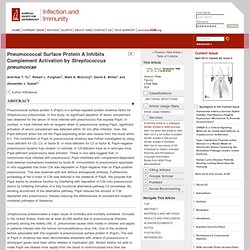

Typhoid fever. Typhoid fever — also known simply as typhoid[1] — is a common worldwide bacterial disease transmitted by the ingestion of food or water contaminated with the feces of an infected person, which contain the bacterium Salmonella enterica enterica, serovar Typhi.[2] The disease has received various names, such as gastric fever, abdominal typhus, infantile remittant fever, slow fever, nervous fever and pythogenic fever.

The name typhoid means "resembling typhus" and comes from the neuropsychiatric symptoms common to typhoid and typhus.[3] Despite this similarity of their names, typhoid fever and typhus are distinct diseases and are caused by different species of bacteria.[4] Pneumococcal Surface Protein A Inhibits Complement Activation by Streptococcus pneumoniae. Streptococcus pneumoniaeis a major cause of morbidity and mortality worldwide.

Annually in the United States, there are at least 40,000 deaths due to pneumococcal infection, primarily among the elderly (10). S. pneumoniae causes otitis media in children and sepsis in patients infected with the human immunodeficiency virus (14). One of the virulence factors associated with this organism is pneumococcal surface protein A (PspA). The role of PspA in virulence has been demonstrated elsewhere with strains of pneumococci in whichpspA genes have been either deleted or inactivated (22). Streptococcus pneumoniae.